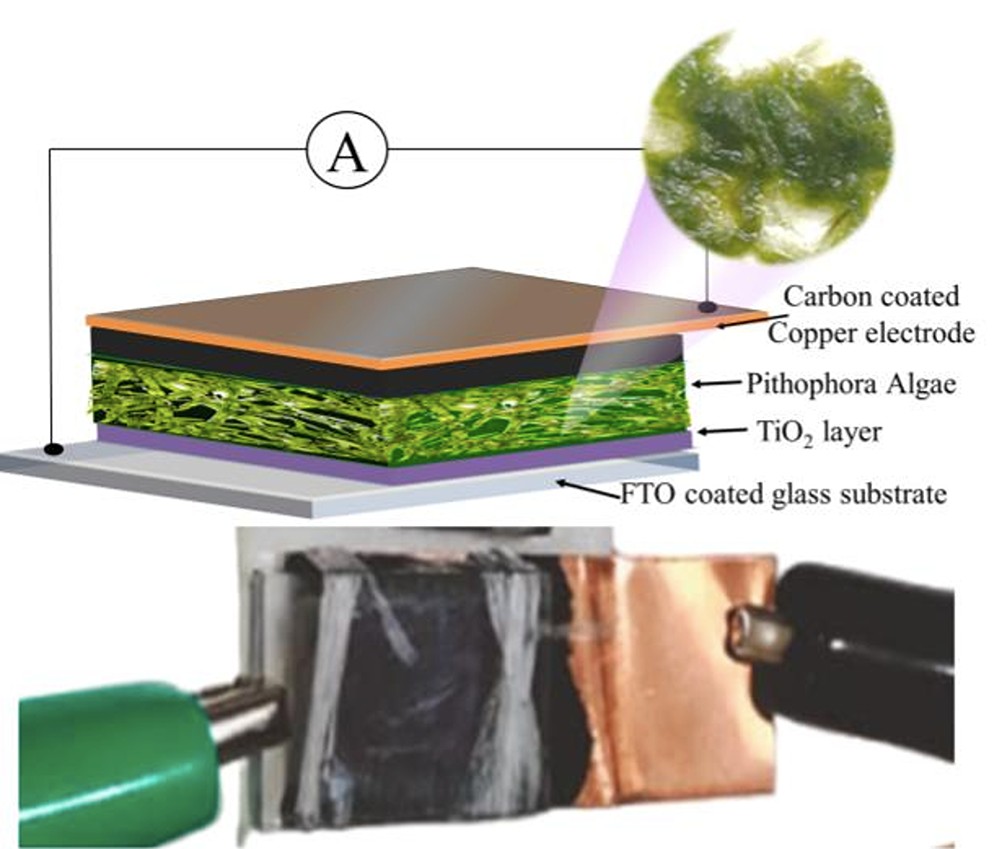A research team from Indian university Amrita Vishwa Vidyapeetham has developed solar cells from living algae.
The team fabricated the bio-photovoltaic device using the freshwater filamentous macroalgae pithophora as a photoactive material. The chosen algae belong to the green algae family and is typically found growing at the bottom of aquatic habitats or forming dense mats on the water’s surface.
The researchers collected the algae from a pond and they cleaned and crushed it into small fragments. They then fabricated a device by sandwiching the algal biofilm between an activated carbon-coated copper top electrode and a titanium oxide-coated (TiO2) fluorine-doped tin oxide (FTO) bottom electrode. The TiO2 compact layer was used as the electron transport layer (ETL) and carbon was used as the hole transporting layer (HTL).
Their work is presented in the research paper Sustainable power generation from live freshwater photosynthetic filamentous macroalgae Pithophora, published in the Journal of Science: Advanced Materials and Devices. The paper says it is “possibly the first reporting work [where] freshwater live macroalgae generates electricity by sandwiching it in between two modified electrodes which collect the charge carriers”.
The research paper details that the device, with an area of 1 cm2, generated an open-circuit voltage of 0.35 V and a short-circuit current of 10.19 μA. When the device was exposed to UV light with a wavelength of 365 nm, the device exhibited a photocurrent of 1.25 mA and a photovoltage of 0.5V, without any applied bias.
The device also performed under ambient conditions including natural sunlight, when 10 devices connected in a series delivered 5.53 V with 0.6 sun intensity.
The research paper says the findings suggest the technology has the potential for use in low-power IoT-based devices. Sudip Kumar Batabyal, one of the researchers and report authors, told pv magazine biological photovoltaic technology has the potential to be a sustainable alternative to traditional solar cells, as it does not require the use of expensive or toxic materials and can be grown using renewable resources.
However, Batabyal explained the technology still faces challenges such as low efficiency and scalability. He said this was “due to the presence of a liquid reservoir which needs to be overcome before it can be widely adopted as a viable energy source”.
“Though the current device delivered low power compared to [silicon] technology, this green PV technology will be the future sustainable solution for solar power generation,” he added.
In November, South Korean researchers developed a cell by merging green algae with carbon nanofibers. Earlier this month, researchers from Spain’s University of Cordoba identified a bacterial community that could be utilized with microalgae for the commercialization of hydrogen produced through microbial metabolism.
This content is protected by copyright and may not be reused. If you want to cooperate with us and would like to reuse some of our content, please contact: editors@pv-magazine.com.








By submitting this form you agree to pv magazine using your data for the purposes of publishing your comment.
Your personal data will only be disclosed or otherwise transmitted to third parties for the purposes of spam filtering or if this is necessary for technical maintenance of the website. Any other transfer to third parties will not take place unless this is justified on the basis of applicable data protection regulations or if pv magazine is legally obliged to do so.
You may revoke this consent at any time with effect for the future, in which case your personal data will be deleted immediately. Otherwise, your data will be deleted if pv magazine has processed your request or the purpose of data storage is fulfilled.
Further information on data privacy can be found in our Data Protection Policy.